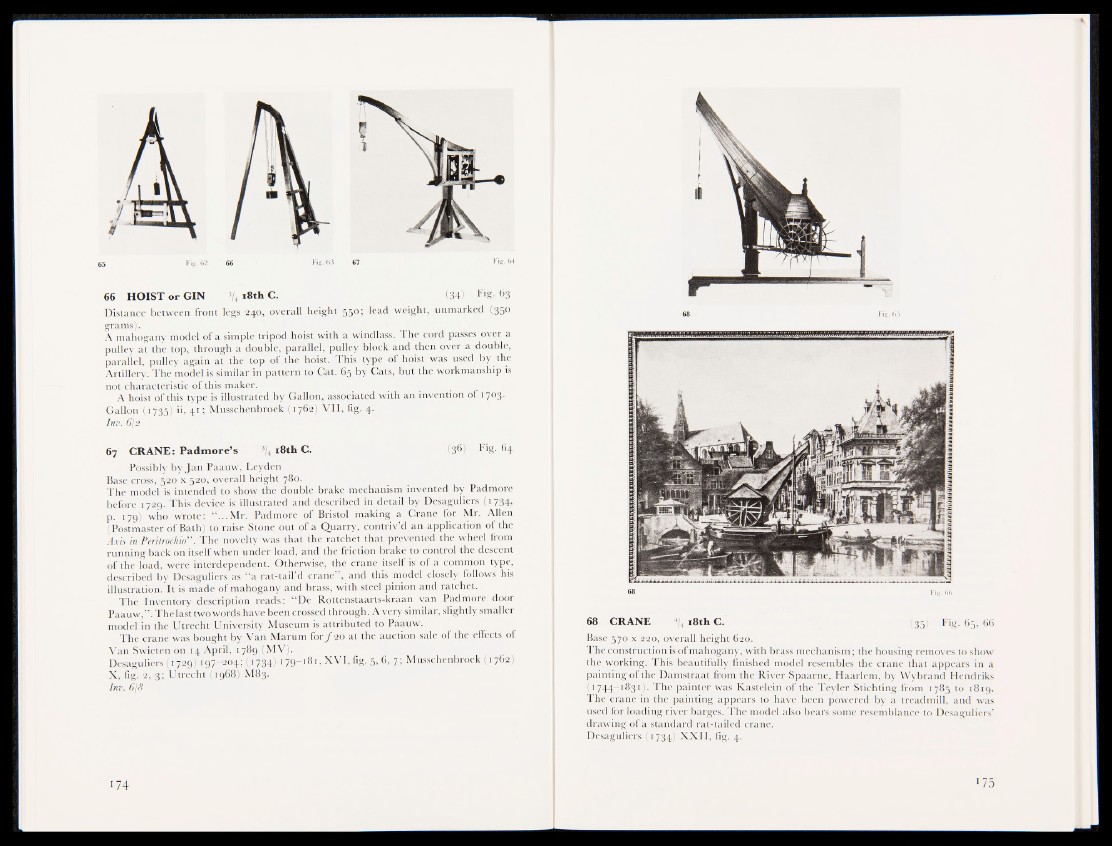
66 HOIST or GIN s/4 18th C. ;J * 34) Fig- 63
Distance between front legs 240, overall height 350; lead weight, unmarked (35°
grams).
A mahogany model of a simple tripod hoist with a windlass. The cord passes over a
pulley at the top, through a double, parallel, pulley block and then over a double,
parallel, pulley again at the top of the hoist. This type of hoist was used by the
Artillery. The model is similar in pattern to Cat. 65 by Cats, but the workmanship is
not characteristic of this maker.
A hoist of this type is illustrated by Gallon, associated with an invention of 1703.
Gallon (1735) ii, 4r| Musschenbroek (1762) VII, fig. 4.
Inv. 6/2
67 CRANE: Padmore’s 3/4 18th C. Fig. 64^
Possibly by Jan Paauw, Leyden
Base cross, 520 x 520, overall height 780.
The model is intended to show the double brake mechanism invented by Padmore
before 1729. This device is illustrated and described in detail by DesagulierM 1734,
p. 179) who wrote: “ ...Mr. Padmore of Bristol making a Crane for Mr. Allen
(Postmaster of Bath) to raise Stone out of a Quarry, contriv’d an application of the
Axis in Peritrochio” . The novelty was that the ratchet that; prevented the wheel from
running back on itself when under load, and the friction brake to contrmthe descent
of the load, were interdependent. Otherwise, the crane itself is^of a common type,
described by Desaguliers as “ a rat-tail’d crane” , and this model cjlsely follows his
illustration. It is made of mahogany and brass, with steel pinion and ratchet.
The Inventory description reads: “ De Rottenstaarts-kraan van Padmore door
Paauw,” . The last two words have been crossed through. A very similar, slightly smaller
model in the Utrecht University Museum is attributed to Paauw.
The crane was bought by Van Marum for ƒ 20 at the auction sale of the effects of
Van Swieten on 14 April, 1789'(MV).
Desaguliers (1729) 197-204; (1734) 179-181, XVI, fig. 5, <V7; Musschenl.rock (1762I
X, fig. 2, 3; Utrecht (1968) M83.
Inv. 6/8
174
68
68 Fig. 66
68 CRANE 4/4 18th C. (35) Fig. 65, 66
Base 570 x 220, overall height 620.
The construction is of mahogany, with brass mechanism; the housing removes to show
the working. This beautifully finished model resembles the crane that appears in a
painting of the Damstraat from the River Spaarne, Haarlem, by Wybrand Hendriks
(1744—1831). The painter was Kastelein of the Teyler Stichting from 1785 to 1819.
The crane in the painting appears to have been powered by a treadmill, and was
used for loading river barges. The model also bears some resemblance to Desaguliers’
drawing of a standard rat-tailed crane.
Desaguliers (1734) XXII, fig. 4.
175